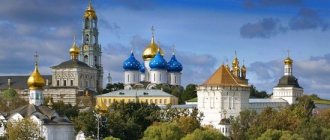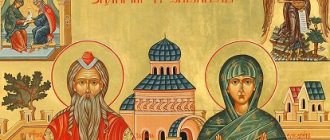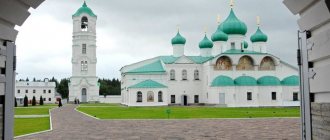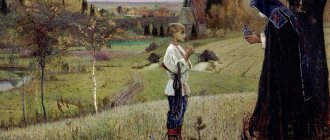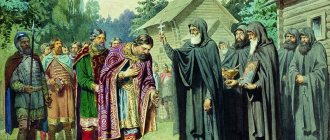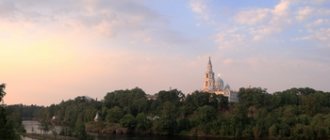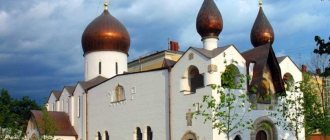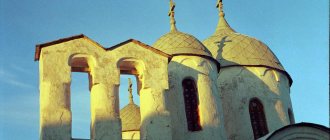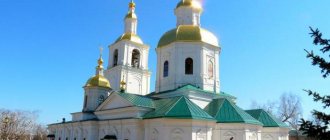Around 1337, where the Trinity Lavra of St. Sergius now stands majestically, there was a dense forest in which Sergius of Radonezh
with his brother Stefan founded a small monastery in order to concentrate in solitude and send prayers to the Creator for help to all of Rus'.
The fact is that this happened in those distant times when Rus' suffered from constant devastating raids by Horde troops. Saving their family from death, the parents of the future Sergius - Kirill and Maria with their three children fled from Rostov to the town of Radonezh
. At the end of their lives, their parents went to the Khotkov Monastery, where they later died. And Bartholomew (the future Sergius of Radonezh) and his brother Stefan decided to become hermits.
Foundation of the Trinity-Sergius Lavra
Together the brothers cut down a cell and a small church in honor of the Trinity
in a remote uninhabited place.
However, Stefan, unable to withstand the harsh life in the forest: the scarcity of lean plant food and the hard work of obtaining it, winter frosts and fear from wild animals, soon went to a comfortable Moscow monastery. The Monk Sergius was left alone
among the fir trees and bears. But he was not alone in soul - God and his Saints were with him.
Rumors about Sergius’s hermit’s life spread throughout Rus', and his presence with God attracted the souls of people seeking righteousness. And people flocked to Sergius, and many remained to live with him - this is how the Sergius community
, which in the first decades of its existence lived in terrible poverty.
But gradually the wilderness turned into a monastic city. a saint
for his boundless love for God and people .
And it was to Saint Sergius that Moscow Prince Dmitry Donskoy
before the decisive battle with the Mongol adversaries - the Battle of Kulikovo. The monk strengthened the spirit of the Russian army by predicting victory, as a result of which Dmitry became the national leader of all Russian lands, and Moscow became the center of the unification of Rus'.
Thanks to the support of the holy elder, Dmitry Donskoy introduced autocracy
and a new order of succession to the throne, which contributed to the centralization of power. St. Sergius always advocated an end to internecine wars, for the unity and strengthening of the Russian state.
After the death of Saint Sergius, both the Russian nobility and the common people flocked to the monastery to pray at the tomb of the Saint. Russian monarchs did not ignore the Lavra - the reign of each of them was marked by some kind of construction or reconstruction on the territory of the monastery. And over time, the monastery turned into a beautiful architectural ensemble.
Trinity Cathedral was erected on the site of the very first wooden church.
, during the construction of which the relics of the Venerable were found. Thus began the formation of the stone temple complex of the Lavra.
In the mid-16th century under Ivan the Terrible
The monastery in Sergiev Posad, in which, by the way, Ivan was baptized, turned into a defensive structure - brick walls were built, fortified with towers, ditches were dug and dams were built.
At the same time, the powerful Assumption Cathedral
, as an image and likeness of Moscow.
During the Time of Troubles
Behind these walls, the monks of the monastery bravely withstood a sixteen-month siege by Polish troops. After the Time of Troubles, times of rapid development of the monastery began. The number of peasant farms belonging to him was much greater than that of the tsar himself. The monastery had factories producing bricks for construction needs. Fruit gardens were created around the monastery, and fish were bred in ponds.
Under Peter the Great
the elegant and fundamental Refectory Church and the Royal Palaces, as well as the Church of John the Baptist, were built. But after Russia entered into confrontation with Sweden and the beginning of the creation of a new capital on the Neva at the beginning of the 18th century, by decree of the Tsar, construction on the territory of the monastery temporarily ceased.
However, in the middle of the 18th century, under Queen Elizabeth
, a new stage in the development of the Lavra began.
A Theological Seminary
was opened , and later the Moscow Theological Academy moved here. Elizabeth herself visited the monastery often, accompanying her visits with entertainment events, for which a special Palace was built outside the walls of the monastery (now it is the Skete Ponds Park). Under Elizabeth, the construction of the Bell Tower began.
By the middle of the 19th century
The monastery was a large and wealthy landowner who traded in grain, household items, and salt. By the beginning of the 20th century, the monastery operated a printing house, hotels, trading shops, and various workshops.
After the revolution, the monastery was closed, the monks were evicted, church valuables were confiscated, many bells were destroyed, the temple premises were used as educational institutions, clubs, and canteens.
But Lavra’s story did not end there.
Monastery under Sergius of Radonezh[edit]
In 1337, Sergius of Radonezh, then still bearing the secular name Bartholomew, and his older brother Stefan, a monk of the Khotkovo Intercession Monastery, settled on Makovets Hill, ten miles from Khotkovo. This event is considered the date of foundation of the Trinity-Sergius Monastery. Soon the brothers erected a small wooden church in the name of the Holy Trinity (it was consecrated in 1340). The first monastic buildings - the Church of the Holy Trinity and several cells - occupied only a small part of the modern territory of the monastery, located in its southwestern corner. After Stephen left for the Epiphany Monastery, the future monk labored alone for some time, but over time other monks settled around his cell. In 1355, with the blessing of the Patriarch of Constantinople Philotheus, Sergius introduced a communal charter in the monastery. The territory of the monastery was divided into three parts - residential, public and defensive. In the center of the monastery there is a new wooden church of the Holy Trinity and a refectory, surrounded on four sides by cells; Behind the cells there were vegetable gardens and household services. The entire monastery was surrounded by a wooden fence (tyn). Another wooden church was built above the gate, in the name of Dmitry of Thessalonica. The plan of the monastery, established then, in general terms has survived to this day. At first the abbot of the monastery was Abbot Mitrofan, who tonsured Bartholomew a monk under the name Sergius. After the death of Mitrofan, the Monk Sergius of Radonezh became the abbot of the monastery.
Soon the Trinity Monastery became the spiritual center of the Russian lands, supported by the Moscow princes. Here in 1380, the Monk Sergius blessed the army of Prince Dmitry Ivanovich, who was going to battle with Mamai. On September 8, 1380, during the Battle of Kulikovo, in violation of the rules of Orthodox monasticism, with the blessing of St. Sergius, the monks-heroes of the Trinity Monastery - Peresvet and Oslyabya - came out onto the battlefield. In 1392, Saint Sergius reposed and was buried in the Church of the Holy Trinity; six months before his death, Sergius handed over the leadership of the monastery to his beloved student Nikon.
History of the Sergius Lavra after the revolution
It is interesting that in the midst of the Great Patriotic War
Stalin entered into negotiations with the Orthodox Church, as a result of which some of the religious buildings were returned to the believers.
This also affected the Sergius Lavra, where in 1946 the building of the Theological Academy began to function again, services resumed in the Assumption Cathedral
, and the monks began to return to the monastery.
In the 90s of the 20th century
Active restoration work began in the Lavra to save architectural and cultural monuments.
Monument to St. Sergius
was built .
Today Sergius Lavra is one of the world centers of Orthodox culture and education. The Moscow Theological Academy and Seminary, Regency and Icon Painting Schools are located here, Christmas and Glin readings, theological conferences, etc. are held.
Author of the article: Kasatkina Tatyana
Restoration of the Lavra[edit]
By the end of the 1930s, some of the Lavra’s monuments were partially rebuilt and adapted for housing and other economic needs that were not typical for them.
The first commission for the protection of monuments of art and antiquity of the Trinity-Sergius Lavra was created back in 1918, but the restoration work carried out under its supervision was not systematic, and there was no single restoration project. The initiator and organizer of systematic restoration work was the director of the Zagorsk Historical and Art Museum S. A. Budaev, the customer was the Zagorsk Museum, and in 1938 the young architect I. V. Trofimov was invited. He was instructed, in furtherance of the 1920 decree signed by Lenin on the appeal of the ensemble of the Trinity-Sergius Lavra to the museum, to prepare a substantiated report to the Council of People's Commissars of the RSFSR on the allocation of funds for the scientific restoration of monuments of this historical and artistic ensemble. In the next two years, he prepared a certificate about the historical and artistic significance of the architectural ensemble of the Lavra and a program for its scientific restoration, a master plan for restoration and restoration work, defect reports, inventories of work and estimates for fifteen objects. Based on these materials, on February 1, 1940, a resolution of the Council of People's Commissars was adopted, according to which the entire complex of monuments to the Trinity-Sergius Lavra within the fortress walls was declared the Zagorsk State Historical and Art Museum-Reserve. I.V. Trofimov was appointed scientific director and chief architect of these works. For their production, a special research and production construction site was organized and an Academic Council was created, approved by the State Committee for Arts; The government allocated an amount of 6 million rubles to carry out the planned work. Architect Academician I.V. Rylsky was appointed chairman of the council, scientific secretary was V. P. Zubov, representative from the customer, the Zagorsk Museum, - architect N. D. Vinogradov. The council included the architect academician I.V. Zholtovsky; engineer P.V. Shchusev; archaeologist Doctor of Historical Sciences A. V. Artsikhovsky; historian S.V. Bakhrushin. At various times, academicians A.V. Shchusev and I.E. Grabar were invited as consultants, who supervised the restoration of paintings from 1940; Lieutenant General, Hero of the Soviet Union D. M. Karbyshev; experts in applied art and painting N. N. Sobolev, D. I. Kiplik, F. Ya. Mishukov; historians - A. G. Novitsky and A. G. Gabrichevsky. There were not enough restoration workers, and in 1945 an arts and crafts school was opened with a three-year training program that trained white masons, modelers, carpenters and other masters of restoration work.
The ensemble of the Trinity Lavra of Sergius took shape over four centuries, from the 15th to the 18th centuries inclusive, and along with the development of the ensemble, the appearance of its individual buildings also changed. The restorer’s task was to find the artistic optimum for each monument, that is, the moment of its highest artistic flowering - for this reason, the start of work was not preceded by the creation of design documentation; during the creation of the project, full-scale openings were carried out. The purpose of the restoration was not to return the ensemble to some specific “optimal year”, but, on the contrary, to show it as an integration or synthesis of all artistic development.
His father, artist V.P. Trofimov, took a great part in the work of I.V. Trofimov. Vikenty Pavlovich’s paintings “The Refectory of the Trinity-Sergius Lavra”, “View from the bell tower of the Trinity-Sergius Lavra”, “In the former Trinity-Sergius Lavra” and others make it possible to see the monuments directly after restoration.
Despite numerous difficulties of the war and post-war times, it was possible to eliminate the emergency condition of a number of monuments, carry out a major restoration of the Hospital Chambers with the Church of Zosima and Savvaty Solovetsky of the 17th century, the Church of the Descent of the Holy Spirit of the 15th century, the white stone basement of the Bell Tower, the eastern part of the refectory of the late 17th century ., Metropolitan chambers, partly the Royal palaces and significant sections of fortress walls and towers. Particularly significant work was carried out on the Hospital Wards, built with new structures and literally returned from oblivion (however, the dismantling of the refectory of the 17th-18th centuries, attached to the Church of Zosima and Savvaty, was considered insufficiently justified). At that time, these were the largest restoration works in the USSR. A 30-meter security zone prohibited for construction was organized around the walls of the monastery.
After 1950, restoration work, carried out mainly on monuments transferred to the Moscow Patriarchate, was carried out by a former student intern of I.V. Trofimova, V.I. Baldin, who in 1963, together with A.G. Ustinov, proposed a comprehensive project for the restoration of the Lavra ensemble. During the restoration in 1956-1959, all buildings and structures of the monastery were freed from the outside institutions that occupied them. By 1970, the bulk of the restoration work was completed. The results of the restoration carried out by Baldin were assessed ambiguously; in particular, I.V. Trofimov noted fundamental errors and damage caused to individual buildings and the entire ensemble of the Trinity-Sergius Lavra as a whole. Restoration continued in the 1970s - a number of objects were recreated under the leadership of architects Yu. D. Belyaev and Yu. N. Shakhov.
In 1993, the architectural ensemble of the Lavra was included in the List of UNESCO World Heritage Sites in Russia.
In the 1990s and 2000s, a number of buildings were returned to the original painting of the walls, the roofs of churches were repaired, and the paintings were restored; The bell tower underwent large-scale restoration. In the spring of 2004, the newly cast Tsar Bell was raised to the bell tower, the ringing of which parishioners first heard on May 30 of the same year, on the feast of Pentecost.
